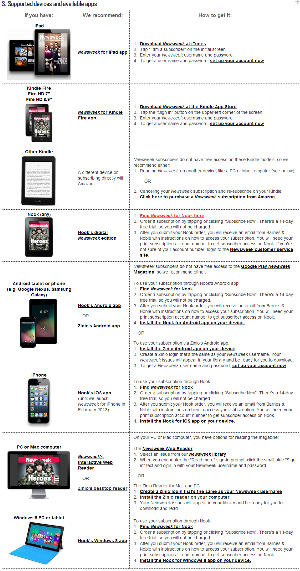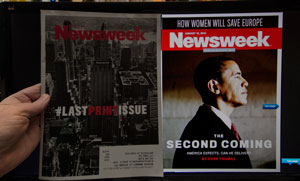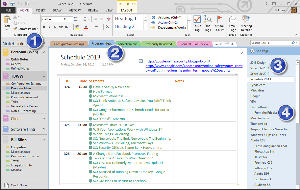A Few Boulders in Newsweek's Road
Newsweek has gone all digital. No more magazines. You already know that. This is good but the transition hasn't been exactly without challenges. One of the most significant problems so far is the lack of standardization among reading platforms. Newsweek was the first major news publication to exit the print arena. Some might give that prize to US News and World Report but it was always a weak third-place finisher behind Time and Newsweek. Whether you'll like the change may depend on what device you use to view Newsweek.
 Because of the current lack of standards, Newsweek must offer lots of options. You can choose the Ipad Newsweek app if you have an Ipad or the Kindle Fire app if you have a Kindle Fire or the Nook reader if you have a Nook or Nook's app for the Android or Zinio's app for the Android or Nook's IOS app for the Iphone or Newsweek's interactive Web reader for any browser or Zinio's desktop reader for PCs or Macs or Nook's Windows 8 app for tablets and PCs. But if you have an original Kindle, you can't read a subscription purchased from Newsweek there.
Because of the current lack of standards, Newsweek must offer lots of options. You can choose the Ipad Newsweek app if you have an Ipad or the Kindle Fire app if you have a Kindle Fire or the Nook reader if you have a Nook or Nook's app for the Android or Zinio's app for the Android or Nook's IOS app for the Iphone or Newsweek's interactive Web reader for any browser or Zinio's desktop reader for PCs or Macs or Nook's Windows 8 app for tablets and PCs. But if you have an original Kindle, you can't read a subscription purchased from Newsweek there.
I tried the Web reader and didn't care for it. When I signed up through Barnes and Noble with the Nook Reader app for Windows 8, the process took more than half an hour and the magazine download took more than an hour on a 15Mbps connection. Although I'm not a fan of Zinio's interface, it appears to be the best option available now. The magazine looks good on the Nook reader but I can't abide by a system that takes an hour to download what other systems handle in 20 or 30 seconds.
The Nook's user interface is better than Zinio's, though. The scroll wheel on the mouse slides from page to page just like it should. With Zinio, it's necessary to click the right edge of the page. But Zinio offers me the current edition of the magazine and the Nook is still showing last week's version. Newsweek's publication date is now Friday instead of Monday.
If Barnes and Noble updates its upload schedule to match Newsweek's publishing schedule and solves the download problem (they're investigating my report), that could be the best platform for reading magazines because the Nook uses the scroll wheel on the mouse to move from page to page. On a touch-sensitive device, you can use standard swipe motions of course, but I like reading on the large monitor.
I can place Newsweek on one screen and continue to use the other screen for normal work. Where was this technology when I was in high school and filling out note cards for the debate team? The monitor is large enough that (depending on the viewer I choose) the magazine on screen is as large as the paper version.
 The Zinio reader on a Windows 8 tablet is frustrating even though some people think that electronic publishing was invented to sell tablets. Because the tablet has a large screen, I had expected Newsweek to look as good there as on the desktop. Actually, it does, but getting out of full-screen mode can be a challenge. Somebody at Microsoft apparently decided to omit the Esc key function from the tablet and that's what the Zinio reader expects when you want to exit full screen view to do something else. I thought that the only way to get back to the desktop involved rebooting the computer and that's not exactly what I'd call good design. As it turns out, the Zinio reader does include an icon that returns to normal view.
The Zinio reader on a Windows 8 tablet is frustrating even though some people think that electronic publishing was invented to sell tablets. Because the tablet has a large screen, I had expected Newsweek to look as good there as on the desktop. Actually, it does, but getting out of full-screen mode can be a challenge. Somebody at Microsoft apparently decided to omit the Esc key function from the tablet and that's what the Zinio reader expects when you want to exit full screen view to do something else. I thought that the only way to get back to the desktop involved rebooting the computer and that's not exactly what I'd call good design. As it turns out, the Zinio reader does include an icon that returns to normal view.
Besides that, the Zinio display works properly only when it's in landscape mode. The page is distorted in a decidedly amateurish way when I hold the tablet in portrait mode.
This, clearly, is the future of publishing and soon it needs to become the present of publishing. One might wonder if "publishing" is the correct therm when there is no press. I am assured that it is because "publishing" can involve distribution in any medium. And besides, we still "dial" phones and anybody under about 30 has probably never seen a phone with dial.
The illustration above shows the issue of Newsweek in print (in my hand) and the current issue of Newsweek on my screen (Zinio viewer, full screen).
The Orchestral Performance of OneNote 2013
Microsoft made what I consider to be a horrible mistake in some of the earlier versions of Office: OneNote was included only in some of the higher-priced editions. Now it's present in all editions, even the Home and Student selection. Although Word and Excel are still the best known and most used applications, OneNote is the hidden gem. And with Office 2013, that's even more true than before.
OneNote is a supremely efficient organizer. Microsoft shows what's new in this short video:
Among the new features is an OCR function that works more or less like magic. Insert an image and if there's any text in it, OneNote will recognize it and make it searchable. It's possible to insert files from other applications into OneNote and then view your notes or files on other computers or tablets.
Use the 2013 version of OneNote in conjunction with SkyDrive and your notes will automatically be synchronized with all of your computers. This alone is an improvement that increases the value of the application.
 OneNote creates nested layers of information. Start with a "notebook" (some of mine include TechByter, Personal, and Software Hints). Then, within the notebooks, you create tabbed folders. My TechByter folder has Configuration Settings and Program Notes, among others). Within each folder, you create pages. Configuration Settings has pages that list the settings used by Adobe Audition, Power Shell, and Dreamweaver; Program Notes includes pages that show which topics are scheduled for future programs and remind me of what was included in previous programs. If needed, I can create sub-pages and sub-pages for the sub-pages.
OneNote creates nested layers of information. Start with a "notebook" (some of mine include TechByter, Personal, and Software Hints). Then, within the notebooks, you create tabbed folders. My TechByter folder has Configuration Settings and Program Notes, among others). Within each folder, you create pages. Configuration Settings has pages that list the settings used by Adobe Audition, Power Shell, and Dreamweaver; Program Notes includes pages that show which topics are scheduled for future programs and remind me of what was included in previous programs. If needed, I can create sub-pages and sub-pages for the sub-pages.
(1) Notebook column. (Notebooks hold folders.)
(2) Folder tabs.
(Folders hold pages.)
(3) Pages. (Pages contain text and illustrations; they can have sub-pages.)
(4) Sub-pages. (Exactly like pages but considered subsidiaries of the pages that own them.)
With all these layers, you might think it's hard to find something in OneNote but nothing could be further from the truth. Two search functions exist: Ctrl-F searches only the current page and Ctrl-E searches every page in every folder in every notebook.
Knowing that you might use OneNote on a desktop system with multiple large-screen monitors or on a smart phone, Microsoft's developers have made the interface flexible. If you have a lot of screen real estate, you'll probably want to leave everything visible. On a tablet or phone, you'll probably hide the parts of the interface that are needed only to search or to open notebooks, folders, and pages. Each of these can be recalled with a single tap or swipe but they stay out of the way when you need to concentrate on the content.
On a desktop or notebook, you'll use the mouse and keyboard to interact with OneNote but on any device with either a touch screen or a digitizing tablet, the ability to draw is handy. You can use a stylus if you want but your finger will work, too. Draw a diagram or take notes by printing them on the screen. Surprisingly, text recognition is surprisingly good, even for my handwriting.
It's Not Word
The OneNote interface might make you think of Word but OneNote lacks even basic structured formatting commands. The ability to define paragraph and character styles would be welcome but that capability has never been present in OneNote.
Users can also apply "tags" to any paragraph in a OneNote document. Nine of these can be inserted by using the Control key plus a number (Ctrl-1 through Ctrl-9) and this makes the process fast. The tags may be renamed and formatting (icon, text color, and highlight color) can be changed but if you want OneNote to use the same settings on multiple computers, you'll have to make the same manual changes on each computer. An export/import capability would be helpful but the process of updating the settings takes only a few minutes (and I maintain a list of my settings in OneNote so I can quickly update any new computer).
The concept of "saving" a note is absent from OneNote. The instant you write something, it's saved and, within a few seconds, any new or updated note will be synchronized to SkyDrive and then to any other computers where you've installed OneNote. I have watched this happen in real time and the process takes just a few seconds. For computers that aren't currently online, expect the updates to occur the next time you open the application from a computer that has an Internet connection.
Short Circuits
Would You Like to Borrow Our Ipad?
At a time when airplanes are overcrowded or late (or both) and add-on charges sap budgets, Delta is trying something new to placate customers: Loaning them an Ipad.
Christine Negroni has the story in the New York Times and she tells the tale of a Michigan man who, on arrival at La Guardia Airport, did something unusual: Rather than grabbing a cab and heading into town (or, as I might do, grabbing a bus and heading for the Roosevelt Avenue subway station), he had lunch in an airport restaurant where he used an Ipad on his table to order lunch, check his e-mail, and even pay the bill.
Delta operates 2 terminals at La Guardia that serve nearly 40,000 passengers per day and the more time (and money) the airlines can convince people to spend in the terminals, the better their bottom lines. The article quotes Rick Blatstein, who's in charge of what's called OTG Management. Blatstein says that the average person spends less than $6 in airport terminals but in Delta's 2 terminals, the average is $3 to $5 above that.
Let's take a $4 average and multiply that times the number of passengers per day and then by the number of non-weekend days in a year. That's about $30 million dollars per year that would otherwise leave the airport in the pockets of passengers. Take in an extra $30 million per year for a few years and that'll add up to a nice sum.
The table-mounted Ipads can also be used to order newspapers and other materials from in-terminal stores who will then deliver the goods to the restaurant.
Negroni cites other amenities that have been added but the Ipads are probably the most interesting of the additions and maybe the most challenging. Delta seems to have solved the theft problem by making the devices part of the furniture but undoubtedly a few will go missing over time. Possibly more concerning is the security aspect. If you use a public terminal to log on and check your e-mail, what might be left behind on the Ipad for the next user? How secure is the connection between the Ipad and the Wi-Fi access point it connects to?
One would like to think that these concerns have been addressed.
The full article is on the New York Times website.
Blockbuster Continues to Shrink
Blockbuster plans to close about 300 stores throughout the US and cut about 3000 jobs as the once high-flying video rental chain continues to implode slowly. The number of stores will drop to around 500.
Blockbuster is now owned by Dish Network. When Dish acquired Blockbuster, the rental firm was in bankruptcy but it still had about 1700 operational locations. Soon it will be less than a third of that and the company isn't doing better anywhere else. The British unit has decided to close 160 stores there and is in the equivalent of bankruptcy.
So far, Dish hasn't been able to make much headway with its plans to use the Blockbuster name to compete against Netflix in streaming video and Redbox. Dish does provide streaming video but there had been plans to use Blockbuster stores to sell its satellite service.
Dish hasn't yet announced which stores are closing. In some cases, the closures are reported to be because the location's lease is expiring. In others, it's because the store is not performing adequately.
Dish reported a 3rd quarter loss of $158 million and lost nearly 20,000 subscribers in the period. So far, no results have been released for the 4th quarter.
Pinterest = Pix and Snip.it = Links
Snip.it seems to think of itself as Pinterest for Web articles. It's a new company that managed to attract the attention of Yahoo and has now been acquired by Yahoo. This could be another example of Yahoo's finely-tuned acquisition skills. Or it might actually succeed.
The space for website-sharing applications seems already to be overcrowded. Lots of Facebook users share links. So do Twitter users. Technorati, StumbleUpon, LinkedIn, Delicious, MySpace and others all provide this capability. And, unlike images (which can be timeless) many Web URLs have a limited shelf life.
Snip.it went live in October 2011 and this week posted a message to users that explained the acquisition. The notice addressed concerns that some users might have about the new parent company and explained how subscribers could retrieve their data. The message said that Snip.it's employees will be absorbed by Yahoo and that Snip.it will no longer provide a service to subscribers.
Google Beats Wall Street Expectations
Google reported better earnings than expected this week for its 4th quarter. Perhaps more important, though, were clues that the company has begun to get a handle on how to make money from mobile computing. As a result, Google shares were up about 5% in after-hours trading.
In recent months, Google had been reducing staff in the areas that support smart phone and tablet operations. The 4th quarter results pushed Google annual revenue past $50 billion and that's a first for the company or, as CEO Larry Page called it, not a bad achievement in 15 years.
The amount advertisers are willing to pay on a cost-per-click basis is continuing to decline but apparently at a slower rate. A year ago, the price drop was 15% quarter-over-quarter and this year it was about 6%.
Analysts have been concerned about Google's long-term viability. The company hasn't had the success it wanted in monetizing mobile devices and its core product is still search as conducted on desktop and notebook computers. The market share for these devices is shrinking and advertisers haven't been willing to pay as much for ads that are delivered to small screens.
OPINION: If anything, advertisers might consider paying more for ads delivered to mobile devices. If the user is already mobile, that user might be standing right outside the merchant's door instead of sitting at a computer on the other side of town.
